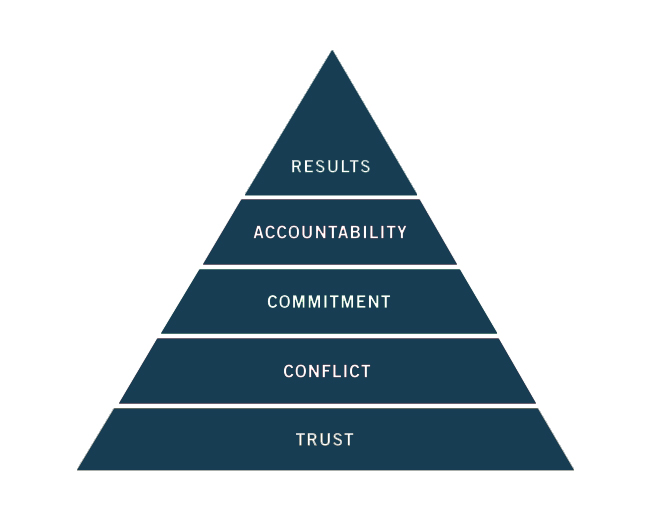5 Team Dysfunctions
- mdicamillo
- Feb, 24, 2019
- Coaching, Team Coaching
- No Comments

According to Patrick Lencioni in his business fable entitled “The Five Dysfunctions of a Team,” teams can often break down due to five fundamental characterological deficiencies. The foundational character trait that all teams must be built on is trust. Other character attributes are layered on top of this base. Momentum Executive Coaching™ has examined each of these, to determine what a lack of that attribute looks like, and how teams that build momentum connect and behave.
Trust
Absence of Trust
- Conceal their weaknesses and mistakes from one another
- Hesitate to ask for help or provide constructive feedback
- Hesitate to offer help outside their own areas of responsibility
- Jump to conclusions about the intentions and attitudes of others without attempting to clarify them
- Fail to recognize and tap into one another’s skills and experiences
- Waste time and energy managing their behaviors for effect
- Hold grudges
- Dread meetings and find reasons to avoid spending time together
Trusting Teams
- Admit weaknesses and mistakes
- Ask for help
- Accept questions and input about their areas of responsibility
- Give one another the benefit of the doubt before arriving at a negative conclusion
- Take risks in offering feedback and assistance
- Appreciate and tap into one another’s skills and experiences
- Focus time and energy on important issues, not politics
- Offer and accept apologies without hesitation
- Look forward to meetings and other opportunities to work as a group
Conflict
Fear Conflict
- Have boring meetings
- Create environments where back-channel politics and personal attacks thrive
- Ignore controversial topics that are critical to team success
- Fail to tap into all the opinions and perspectives of team members
- Waste time and energy with posturing and interpersonal risk management
Healthy Conflict
- Have lively interesting meetings
- Extract and exploit the ideas of all team members
- Solve real problems quickly
- Minimize politics
- Put critical topics on the table for discussion
Commitment
Failing to Commit
- Creates ambiguity among the team about direction and priorities
- Watches windows of opportunity close due to excessive analysis and unnecessary delay
- Breeds lack of confidence and fear of failure
- Revisits discussions and decisions again and again
- Encourages second-guessing among team members
Commitment
- Creates clarity around direction and priorities
- Aligns the entire team around common objectives
- Develops an ability to learn from mistakes
- Takes advantage of opportunities before competitors do
- Moves forward without hesitation
- Changes direction without hesitation or guilt
Accountability
Avoiding Accountability
- Creates resentment among team members who have different standards of performance
- Encourages mediocrity
- Misses deadlines and key deliverables
- Places an undue burden on the team leader as the sole source of discipline
Mutual Accountability
- Ensures that poor performers feel pressure to improve
- Identifies potential problems quickly by questioning one another’s approaches without hesitation
- Establishes respect among team member who are held to the same high standards
- Avoids excessive bureaucracy around performance management and corrective action.
Results
Misses Results
- Stagnates / fails to grow
- Rarely defeats competitors
- Loses achievement-oriented employees
- Encourages team members to focus on their own careers and individual goals
- Is easily distracted
Results Oriented
- Retains achievement-oriented employees
- Minimizes individualistic behavior
- Enjoys success and suffers failure acutely
- Benefits from individuals who subjugate their own goals / interests for the good of the team
- Avoids distractions.